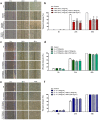The Role of Galectin-9 as Mediator of Atopic Dermatitis: Effect on Keratinocytes
- PMID: 33923930
- PMCID: PMC8073283
- DOI: 10.3390/cells10040947
The Role of Galectin-9 as Mediator of Atopic Dermatitis: Effect on Keratinocytes
Abstract
Galectin-9 (Gal-9) is a beta-galactoside-binding protein with a variety of biological functions related to immune response. However, in allergic diseases, its mechanism of action is not fully understood. This study evaluates the expression pattern of Gal-9 in patients with atopic dermatitis (AD), in ovalbumin (OVA)-induced experimental atopic dermatitis (AD) in mice, as well as its effect on human keratinocytes. The skin of OVA-immunized BALB/c mice was challenged with drops containing OVA on days 11, 14-18, and 21-24. HaCaT cells were cultured in the following experimental conditions: control (growth medium only) or stimulated with TNF-α/IFN-γ, or IL-4, or IL-17 with or without Gal-9 treatment. AD was characterized by increased levels of Gal-9 in mouse and human skin, especially in the epidermis, and with a marked influx of Gal-9 positive eosinophils and mast cells compared to the control group. Gal-9 showed an immunomodulatory effect on keratinocytes by decreasing the release of IL-6 by IL-4-stimulated keratinocytes or increasing the IL-6 and RANTES levels by IL-17- or TNF-α/IFN-γ-stimulated cells, respectively. Under IL-17, Gal-9 treatment also altered the proliferation rate of cells. Overall, increased levels of Gal-9 in AD skin contribute to the control of inflammatory response and the proliferative process of keratinocytes, suggesting this lectin as a relevant therapeutic target.
Keywords: IL-6; atopic dermatitis; eosinophil; galectin; keratinocyte; mast cell; skin inflammation.
Conflict of interest statement
The authors declare no conflict of interest.
Figures







Similar articles
-
Protective role of Galectin-7 for skin barrier impairment in atopic dermatitis.Clin Exp Allergy. 2020 Aug;50(8):922-931. doi: 10.1111/cea.13672. Epub 2020 Jun 14. Clin Exp Allergy. 2020. PMID: 32474952 Free PMC article.
-
Anti-inflammatory effect of galectin-1 in a murine model of atopic dermatitis.J Mol Med (Berl). 2017 Sep;95(9):1005-1015. doi: 10.1007/s00109-017-1566-9. Epub 2017 Jun 29. J Mol Med (Berl). 2017. PMID: 28664215
-
Expression Pattern and Immunoregulatory Roles of Galectin-1 and Galectin-3 in Atopic Dermatitis and Psoriasis.Inflammation. 2022 Jun;45(3):1133-1145. doi: 10.1007/s10753-021-01608-7. Epub 2022 Jan 15. Inflammation. 2022. PMID: 35031944
-
IL-22 in Atopic Dermatitis.Cells. 2024 Aug 22;13(16):1398. doi: 10.3390/cells13161398. Cells. 2024. PMID: 39195286 Free PMC article. Review.
-
Galectin-3 and the skin.J Dermatol Sci. 2011 Nov;64(2):85-91. doi: 10.1016/j.jdermsci.2011.07.008. Epub 2011 Aug 11. J Dermatol Sci. 2011. PMID: 21889881 Free PMC article. Review.
Cited by
-
Galectin-9: diverse roles in skin disease.Front Allergy. 2025 Jul 16;6:1614277. doi: 10.3389/falgy.2025.1614277. eCollection 2025. Front Allergy. 2025. PMID: 40741333 Free PMC article. Review.
-
The role of galectins in the regulation of autophagy and inflammasome in host immunity.Semin Immunopathol. 2024 Jul 23;46(3-4):6. doi: 10.1007/s00281-024-01018-5. Semin Immunopathol. 2024. PMID: 39042263 Review.
-
Design and Evaluation of Paeonol-Loaded Liposomes in Thermoreversible Gels for Atopic Dermatitis.Gels. 2023 Mar 5;9(3):198. doi: 10.3390/gels9030198. Gels. 2023. PMID: 36975647 Free PMC article.
References
Publication types
MeSH terms
Substances
Grants and funding
LinkOut - more resources
Full Text Sources
Other Literature Sources
Research Materials

